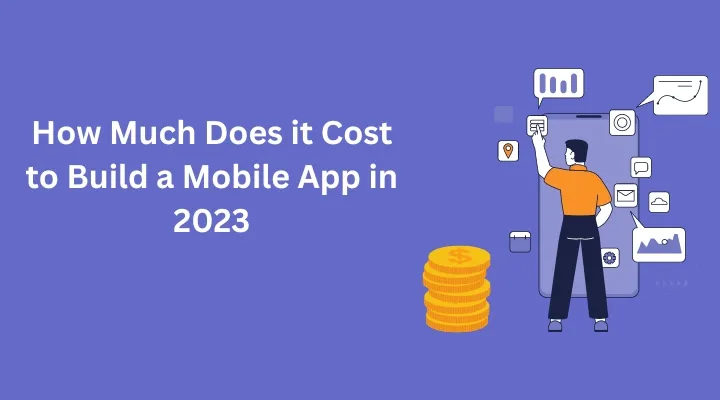How Much Does it Cost to Build a Mobile App in 2023?

So, you're gearing up to bring your brilliant mobile app idea to life in 2023. Exciting times ahead! But amidst the enthusiasm, one critical question looms large: "How much is it going to cost?" Don't worry; we've got you covered with a candid breakdown of what goes into the price tag of building a mobile app in today's dynamic tech landscape.
Understanding the Average Mobile App Development Cost Estimate
In a nutshell, the cost to develop a mobile app can range from approximately ₹2,00,000 to ₹12,00,000. However, for complex, customized apps, the costs can exceed ₹20,00,000. The total cost varies due to several factors, including app complexity, features, development approach, and more. To arrive at a more precise estimate, it's crucial to analyze these factors in depth.
Factors Influencing Mobile App Development Costs
Mobile App Complexity
Simple Apps: ₹3,00,000 - ₹10,00,000
Medium Complex Apps: ₹5,00,000 - ₹15,00,000
Highly Complex Apps: ₹10,00,000 - ₹20,00,000 and above
App Features and Functionalities
User Login, Profile Completion, Messaging, Push Notifications, Basic Admin Panel, Payments, Maps, Calls, and more.
App Design and Animation
App Design Research, UI/UX Design, Branding, Animations, Wireframing, and more.
App Platform
Native Apps (Android & iOS): ₹500,000 - ₹1,000,000
Cross-Platform Apps: ₹200,000 - ₹10,00,000
Web Apps: ₹150,000 - ₹500,000
App Maintenance
App Bug Fixes, Design Changes, Regular Updates, and IT Support.
Code Reuse
Reusing Existing Code: 70% - 80% reduction in development cost.
Size and Location of Development Team
Factors include Developers, UI/UX Designers, Project Managers, QA Specialists, Business Analysts, DevOps, and Solution Architects.
Reducing Mobile App Development Costs
Prioritize Features Early On:
Begin with a Minimum Viable Product (MVP) and prioritize essential features for quicker delivery.
Code Reuse and No-Code Templates:
By strategically repurposing existing code components and utilizing no-code templates, developers can streamline the development journey significantly. This not only expedites the process but also cuts down on costs substantially. At Start10x, with code reuse and no-code templates, we're rewriting the rules of cost-efficient app development.
Plan for the Future:
Consider both short-term and long-term goals to accommodate changes in user requirements and market trends.
Consider Cross-Platform Development:
Develop cross-platform apps to target both Android and iOS users, saving development time and costs. Technologies like React Native and Flutter have gained immense popularity due to their ability to create apps that work seamlessly on both Android and iOS platforms.
Optimize App Design:
Focus on essential design elements and animations, avoiding excessive customization that can drive up costs.
Popular global apps and their development costs
In the ever-evolving world of mobile applications, a handful of global apps have managed to capture the world's attention and shape the way we interact with technology. These apps offer a glimpse into the boundless possibilities of mobile app development. Let's delve into a few of these powerhouses:
1. Facebook: With over 2.8 billion monthly active users, Facebook has redefined social networking. Creating an app of this magnitude involves intricate features such as news feeds, photo sharing, and messaging. The development cost for a comprehensive app like Facebook can go up to ₹50,00,000.
2. WhatsApp: WhatsApp: WhatsApp, boasting 2 billion monthly users, has changed the landscape of instant messaging. Its end-to-end encryption and intuitive interface make it a favorite among users. Developing a secure messaging app akin to WhatsApp might require an investment of ₹50,00,000-₹70,00,000.
3. Instagram: Instagram: The visual storytelling platform, Instagram, has gathered over 1.3 billion monthly active users. Its filters, stories, and explore features have become a part of modern culture. To create an engaging app like Instagram, the development cost could be around ₹35,00,000 to ₹55,00,000
4. Uber: Uber, an app that has revolutionized the way we commute, has a presence in over 900 metropolitan areas. Real-time tracking, secure payments, and a seamless user experience are at the core of its success. The development cost for a robust ride-hailing app like Uber might fall between ₹35,00,000 to ₹75,00,000.
5. Spotify: Spotify, the music streaming giant with approximately 345 million users, has made music accessible to people around the globe. Features such as curated playlists and personalized recommendations make it stand out. Developing a music streaming app like Spotify might range from ₹30,00,000 to ₹70,00,000.
These are rough estimates and actual costs can vary widely based on the complexity of features, development resources, design intricacies, and other factors. The monumental success of these global apps underscores the transformative potential of mobile app development in reshaping the digital landscape.
In conclusion, estimating the cost of building a mobile app involves a complex interplay of factors. By understanding the components that impact costs and by following strategic approaches to development, businesses can navigate the app development process effectively, ensuring a successful and cost-efficient outcome in the dynamic world of mobile applications.
FAQs
Q1: How Much Does it Cost to Build a Mobile App for Android and iOS?
The cost varies based on the app's complexity, features, and platform. On average, native apps for Android or iOS can range from ₹500,000 - ₹1,000,000.
Q2: What Factors Affect App Development Costs?
App complexity, features and functionalities, app category, design elements, platform, and team size all contribute to development costs.
Q3: Can I Reuse Code to Reduce Costs?
Reusing existing code can significantly reduce costs, usually by 60% - 70%. This is especially true when developing similar features across platforms.